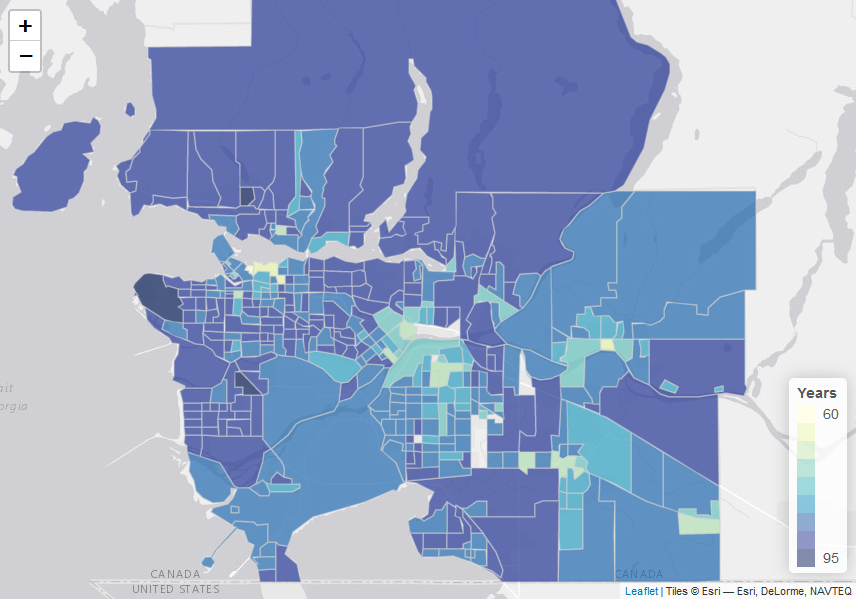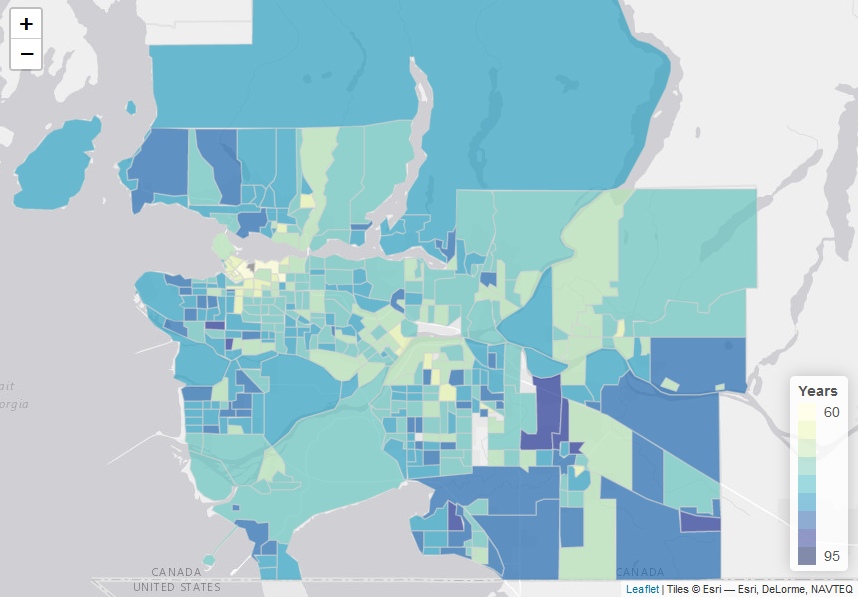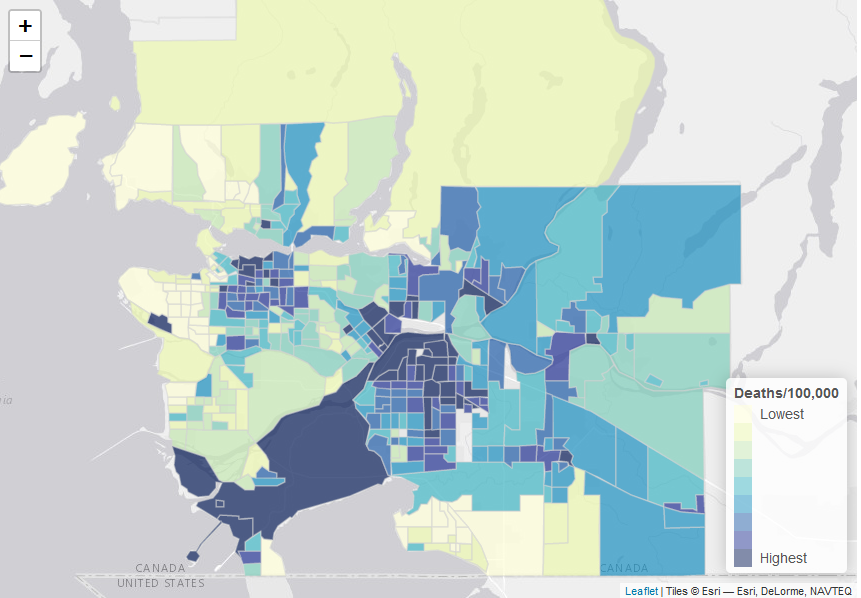This interactive map shows the life expectancy in your neighbourhood compared to others in Vancouver
 A map created as part of an extensive study from UBC shows life expectancy averages by neighbourhood.
A map created as part of an extensive study from UBC shows life expectancy averages by neighbourhood.
It's considered one of the healthiest cities in the world, but an interactive map put together by local researchers shows just how much a Vancouver resident's lifespan can vary by neighbourhood.
The map, published as a result of a University of British Columbia study, allows users to zoom into their own neighbourhood in Vancouver and surrounding cities, and view the average life expectancy based on census results.
For example, looking at 2016 census data, the mean life expectancy in an area that includes Vancouver's Downtown Eastside is quite low, at 60.7 years.
But in the area of the city that includes the UBC endowment lands, the mean age is just over 90.

And this filter shows how life expectancies in the region overall were much lower in 1991, than above in 2016.

It's perhaps not surprising that overall life expectancy has increased over the period examined in the study, but it may be a surprise to see that while it's much higher in many parts of Metro Vancouver now, areas including the Downtown Eastside and Haney, in Maple Ridge, still have a life expectancy of less than 75.
"Statistically, residents of those areas have life expectancies that are comparable to the average life expectancies in Indonesia (71.8 years) and Russia (73.2 years)," UBC said in a statement.
In areas like West Vancouver, West Point Grey, northwest Richmond and South Surrey, the expectancy is much higher.
The school said it's the first study of its kind in Canada – the first to analyze life expectancy and causes of death at such a level over decades.
Users can not only check the average life expectancy in their neighbourhood according to the most recent census data (2016), but they can also look back at how it's changed, with data from 1991, 1996, 2001, 2006 and 2011.
UBC attributes some of the disparity to specific causes of death, including HIV/AIDS and sexually transmitted diseases.
"For these causes, some neighbourhoods had a mortality rate 17 times higher than others in the city," the school said.
In a separate tab, they can narrow those results in another way, sorting by census year and even cause of death. The map allows users to look at the region in terms of death attributed to substance use, for example.
The image embedded below shows substance use disorder deaths per 100,000 residents, with the darkest-coloured areas having the highest rates of death, based on 2016 data.

This view of the map shows rates of death due to diabetes and kidney diseases.

More information is available on UBC's website.
All graphics are from the interactive data map created by UBC.
CTVNews.ca Top Stories

N.Y. prosecutors charge Luigi Mangione with murder of UnitedHealthcare CEO, court records show
Late Monday, Manhattan prosecutors filed murder and other charges against Luigi Nicholas Mangione in the killing of UnitedHealthcare's CEO, according to an online court docket.
Union dropped wage demand to 19% over four years in Canada Post negotiations: CUPW
The Canadian Union of Postal Workers (CUPW) has reportedly dropped its wage demand to 19 per cent over four years, CUPW negotiator Jim Gallant told CTV News.
Taxpayer-funded Eras Tour tickets returned by federal minister
While tens of thousands of fans packed Vancouver's BC Place for the last shows of Taylor Swift's Eras Tour this weekend, a federal cabinet minister wasn't one of them.
Sudbury, Ont., family traumatized after hospital said loved one had been released, when in fact they had passed away
Sudbury resident Angela Vitiello says a staff member at Health Sciences North told her that her brother, Allan St. Martin, was released from the hospital late last month when, in fact, he had passed away.
What the upcoming holiday GST relief will mean for consumers
The federal government's GST break will arrive this Saturday, just in time for the last stretch of holiday shopping.
Liberal government survives third Conservative non-confidence vote
Conservative Leader Pierre Poilievre's latest attempt to topple the minority Liberal government in a non-confidence vote failed on Monday, thanks to the New Democrats.
Katie Holmes refutes story about daughter Suri Cruise’s fortune
Katie Holmes has posted a screen grab of a Daily Mail article, which reported that her 18-year old daughter, whose father is Tom Cruise, is now a "millionaire."
Polygamous U.S. sect leader gets 50 years in prison in scheme to orchestrate sex involving children
A polygamist religious leader in the U.S. who claimed more than 20 spiritual “wives” including 10 underage girls was sentenced to 50 years in prison on Monday.
Trudeau says dealing with Trump will be 'a little more challenging' than last time
Prime Minister Justin Trudeau said dealing with incoming president Donald Trump and his thundering on trade will be 'a little more challenging' than the last time.

































